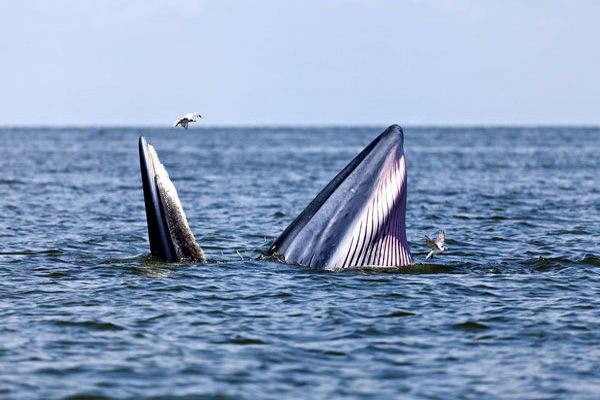Bryde’s Whale

Find A Hotel in Los Cabos
Fantastic deals on hotels in Los Cabos with our booking partners. Amazing discounts on over 100 properties, instant reservation and user reviews/ratings to guarantee you get the hotel you want, when you want it. In many cases you PAY NOTHING now...check it out here!
Bryde’s whales are largely a coastal species, not
often venturing out into the deep oceans. Bryde’s whales are found in
the Sea of Cortez, off the coast of the Baja peninsula, especially
during the sardine migration season over the San Jaime and Golden Gate
Banks.
Bryde’s whales are still under scientific
debate as to their exact taxonomy, there is much debate over possible
subspecies. They reach about 40 feet in length with a dark dorsal
coloration and a white underbelly weighing in at 25 tonnes. They have
the typical Rorqual shape, hydrodynamical streamlined body, the front
third comprising the head and relatively large jaw structure.
Bryde’s whales have twin blowholes and a
falcate dorsal fin located far down its back. The rostrum has 3
prominent ridges, which is the easiest way to distinguish this species
from Sei whales. The tail flukes are broad but seldom break the surface
at the whale moves, however the dorsal fin is quite evident.
Not a lot is known about Bryde’s whales
breeding habits, as there seem to be geo-distinct species with differing
habits. However, Bryde’s whales seem to breed in any season, with a
peak during autumn months in the Northern Hemisphere. Gestation is about
12 months; a 13 foot calf weighing 2000 pounds is born, that the mother
will nurse for 6 to 12 months. They reach sexual maturity between 8 to
13 years of age, typically close to their full size of 40 feet.
Feeding behavior seems to be an opportunistic
medley of strategies and bait. Bryde’s whales have been observed
feeding by surface skimming, underwater lunging and even bubble netting.
Their diet then consists of small schools of bait fish (this is what we
typically observe here in Cabo during the sardine migration), plankton
and crustaceans.
Very little is known about Bryde’s whales and
their behaviors. They have proven to be a difficult species to study,
with what has been described as ‘erratic behavior’. They seem to change
direction underwater with no known provocation, blow bubbles under the
surface and surface at erratic intervals. Typically Bryde’s whales are
found alone or in pairs, normally only found in aggregations around
concentrated food supply.